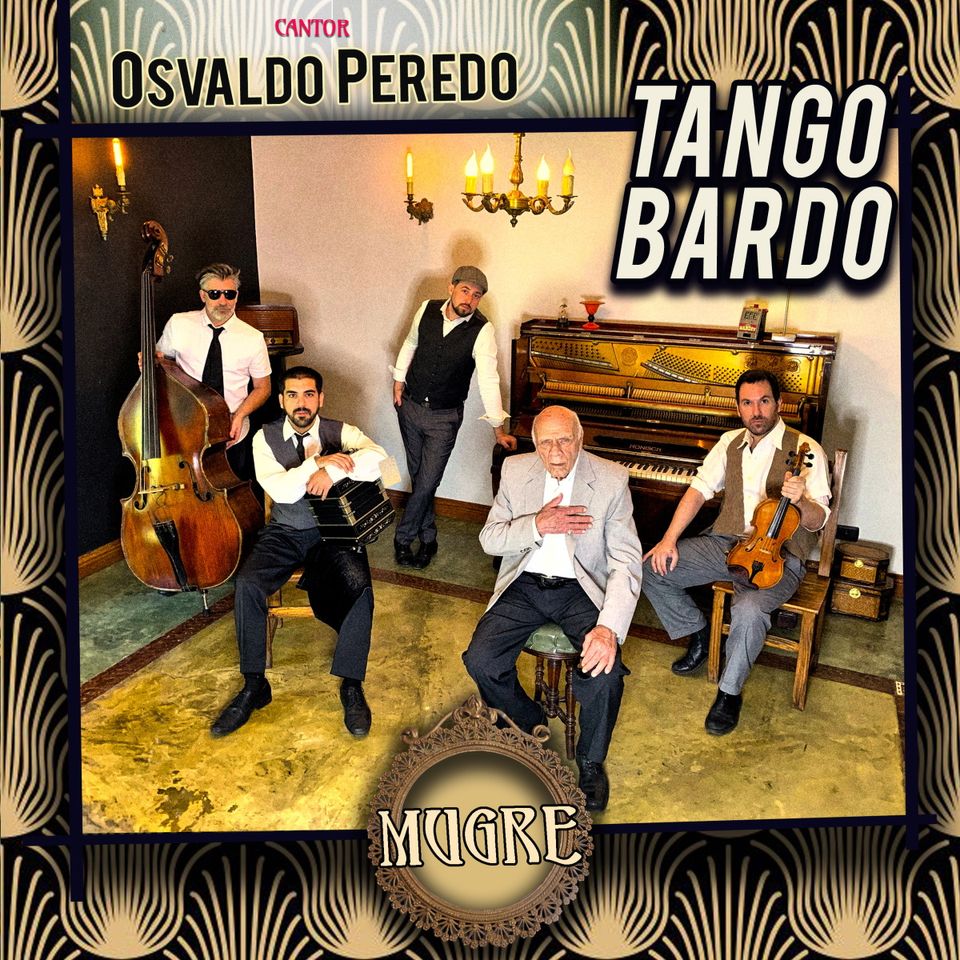Tango Bardo has already released five albums on Bandcamp, and not a single review here, just one tanda! Time to change that.
For the record, I purchased everything they put out, even begged them over e-mail to sell me "Alma de loca", an album they did in collaboration with the singer Cucuza Castiello and that isn't on sale on Bandcamp. I love these guys, and so when I hit refresh on the newest tango releases page on Bandcamp that I monitor daily, trust me when I tell you I was excited.
Yes, Mugre is here.

The music in detail
There are ten tracks included, two of which I would put in the "tango-nuevo" genre (not immediately conductive to dancing) and one being probably a chacarera (La juguetona). Six are instrumentals.
Tango Bardo has already released an EP "Osvaldo Peredo con Tango Bardo" featuring four tracks where they accompany the singer Osvaldo Peredo, and we find additional four here.
Admittedly I didn't know before much about Osvaldo Peredo before. Having been born in 1930, the fact that he is still performing in 2020, when this album was recorded, is astonishing.
You can tell he's not a young man - his voice has a similar color to that of late Alberto Podestá. His intonation is precise, and what he may lack in raw masculine power of his younger contemporaries, he makes up with mature, practiced expression.
The instrumentals
The album opens with a phenomenal rendition of El recodo.
What a way to open! Tango Bardo is like Tesla Model S Plaid, going from 0 to 100 km/h in a blink of an eye. After the supercharged opening, you will find a slower section starting at about 1" mark, with enough lead-in time that should give the dancer time to adapt. He will be rewarded with an especially touching passage that eventually converts back to a frenzied rush.
Una noche de garufa has a slow intro, after which the band outcompetes Tanturi at his own game.
I don't say this lightly, I love Tanturi's take as much as anyone, and I played it 13x in 2019 alone. What Tango Bardo does so well is to make their accents and phrasing ridiculously sharp and pointed, going as close as possible to breaking the strings on the violin without actually doing so, and this takes the rhythmical potential of Una noche de garufa to its logical conclusion.
Then there is Flor amorosa.
Originally a song from Brazil, the band remade it into a swift milonga, and the remake is fabulous. The theme is cheerful, infectious, and the underlying milonga beat is ever-present - it begs you to jump on the dance floor with whomever is close by.
The vocals
I appreciated that while they are wild and borderline demonic when playing alone, Tango Bardo created a wide open space for Osvaldo Peredo to shine. In no way are these vocals a show-time for the singer alone like they often were in 1950s, though: the singer here is still part of the band.
Ahora no me conocés is swift and resolute, delivering on the motive's promise in a unique way. The band does not take many cues from the many classical renditions there are, be it Biagi's, D'Agostino's, or Pugliese's. The tempo is ~ 63BPM and stays the same throughout.
Confidencias is a phantastic tune, and I find it puzzling that it was recorded only once in 1959 by the singer Jorge Vidal. It might be the strongest vocal on the album, and a very warmly welcome addition due to its rarity. Definitely on the darker side, it's a supremely touching piece, moving slowly but steadily to its rather drained resolution.
Solamente ella has an unusually dissonant start, however its motive kicks in shortly. The tempos are slower, at around 57 BPM, and I belive Peredo's old voice is perfect for what the song is about. The longing for a woman long gone is here:
She came one afternoon and it was sad
phantom of silence and song,
she came from a world that does not exist.
Empty of hope the heart.
Finally, Gólgota. Similar in its drive to Ahora no me conocés, it is likewise resolute and firm. The canonical versions are from 1938 (Biagi, Lomuto) when this singer was 8 years old. I loved how hard he pronounced the last syllables of the lyrics in the final part to prepare us for the bold ending - you could almost imagine him stomping on the ground as he finishes.
The rest
As mentioned in the beginning, there are two tracks that I consider to be "Tango nuevo" in the sense they did not particularly move me to dance. As I only care about music for dancing, I'll mention them for completeness' sake alone.
Bordoneo y 900 starts like a tango, then develops into a milonga, switches back, then ends with a milonga again. The slow parts run at ~ 40 BPM.
Ave Maria is beautiful but also slow at 44 BPM, a classical concert piece in character.
La juguetona has a 3/4 beat and - I could be wrong but it does sound like a chacarera to me. Perhaps fun if you like to throw one into your sets; I don't.
Never mind my grumbling. This is not to dismiss these three tracks, only separate them from the danceable ones.
In closing
What a delight this album was! The tango drought is far from over, and so it's particularly heart-warming that the artists are still at work. Please support them with your dollars and euros and buy their music as I do. That's the best relief we can give to Buenos Aires now (other than donating extra), and in general the best way to support musicians in any time.
